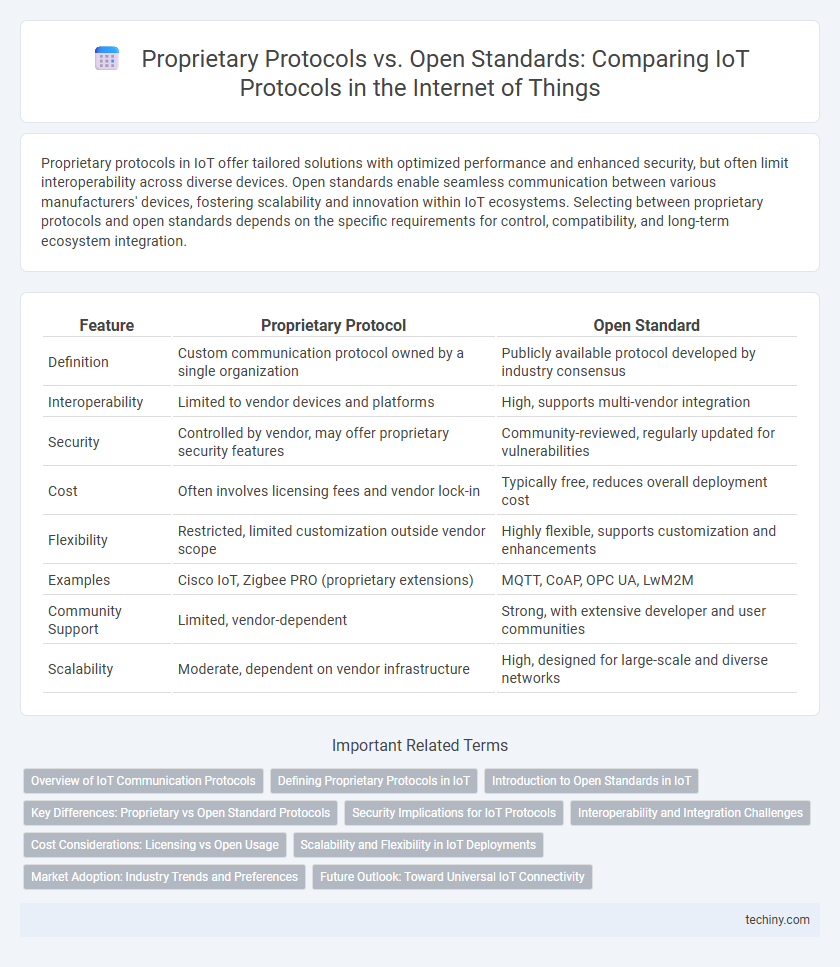Proprietary protocols in IoT offer tailored solutions with optimized performance and enhanced security, but often limit interoperability across diverse devices. Open standards enable seamless communication between various manufacturers' devices, fostering scalability and innovation within IoT ecosystems. Selecting between proprietary protocols and open standards depends on the specific requirements for control, compatibility, and long-term ecosystem integration.
Table of Comparison
| Feature | Proprietary Protocol | Open Standard |
|---|---|---|
| Definition | Custom communication protocol owned by a single organization | Publicly available protocol developed by industry consensus |
| Interoperability | Limited to vendor devices and platforms | High, supports multi-vendor integration |
| Security | Controlled by vendor, may offer proprietary security features | Community-reviewed, regularly updated for vulnerabilities |
| Cost | Often involves licensing fees and vendor lock-in | Typically free, reduces overall deployment cost |
| Flexibility | Restricted, limited customization outside vendor scope | Highly flexible, supports customization and enhancements |
| Examples | Cisco IoT, Zigbee PRO (proprietary extensions) | MQTT, CoAP, OPC UA, LwM2M |
| Community Support | Limited, vendor-dependent | Strong, with extensive developer and user communities |
| Scalability | Moderate, dependent on vendor infrastructure | High, designed for large-scale and diverse networks |
Overview of IoT Communication Protocols
IoT communication protocols fall into two main categories: proprietary protocols and open standards, each facilitating device connectivity and data exchange uniquely. Proprietary protocols, developed and controlled by specific companies, offer optimized performance and enhanced security tailored to particular devices but may limit interoperability across different vendors. Open standard protocols like MQTT, CoAP, and Zigbee promote broad compatibility, scalability, and community-driven improvements essential for large-scale IoT deployments and cross-platform communication.
Defining Proprietary Protocols in IoT
Proprietary protocols in IoT are communication standards developed and controlled by specific companies, enabling tailored features and enhanced security within their ecosystems. These protocols often offer optimized performance and compatibility for particular devices but may limit interoperability with other systems. Emphasizing exclusivity, proprietary protocols can restrict integration flexibility compared to open standards widely supported across diverse IoT platforms.
Introduction to Open Standards in IoT
Open standards in IoT protocols enable widespread interoperability, allowing diverse devices and systems to communicate seamlessly across different manufacturers and platforms. These standards foster innovation and scalability by promoting transparent, community-driven development models that reduce vendor lock-in and facilitate integration. Common examples include MQTT, CoAP, and OPC UA, which support flexible, secure, and efficient data exchange essential for IoT ecosystems.
Key Differences: Proprietary vs Open Standard Protocols
Proprietary IoT protocols are developed and controlled by specific companies, offering optimized performance and tailored security features but often limiting interoperability and device compatibility. Open standard protocols, such as MQTT, CoAP, and Zigbee, promote broad interoperability, vendor neutrality, and community-driven enhancements, facilitating wider adoption and integration across diverse IoT ecosystems. The key difference lies in customization and control versus universal accessibility and standardization, impacting scalability and long-term sustainability in IoT deployments.
Security Implications for IoT Protocols
Proprietary protocols in IoT often lack transparency, leading to limited peer review and potential undiscovered security flaws, whereas open standards benefit from extensive community scrutiny that enhances vulnerability detection and patching. Open standard protocols like MQTT, CoAP, and LwM2M implement robust encryption and authentication methods standardized across devices, improving overall security interoperability. However, proprietary protocols might offer customized security measures tailored to specific applications but risk vendor lock-in and slower response to emerging cyber threats.
Interoperability and Integration Challenges
Proprietary protocols in IoT often limit interoperability due to vendor-specific implementations, creating integration challenges across diverse devices and platforms. Open standards such as MQTT, CoAP, and OPC UA promote seamless communication and easier integration by adhering to universally accepted specifications. Interoperability issues common with proprietary protocols can lead to increased development costs and slower deployment times in complex IoT ecosystems.
Cost Considerations: Licensing vs Open Usage
Proprietary IoT protocols often involve licensing fees and vendor lock-in, increasing overall deployment and maintenance costs for businesses. Open standard IoT protocols reduce expenses by allowing free use, fostering interoperability among diverse devices and promoting scalable, cost-effective network expansion. Cost considerations are crucial when selecting protocols, as open standards typically offer financial and technical flexibility compared to proprietary options.
Scalability and Flexibility in IoT Deployments
Proprietary protocols often limit scalability and flexibility in IoT deployments due to vendor lock-in and restricted interoperability, hindering seamless integration of diverse devices. Open standard protocols like MQTT and CoAP promote scalability by enabling interoperability across multiple platforms and vendors, facilitating easier expansion and customization. The flexibility inherent in open standards supports dynamic IoT ecosystems, allowing for faster adoption of new technologies and adaptation to evolving deployment requirements.
Market Adoption: Industry Trends and Preferences
Proprietary protocols in IoT often face limited market adoption due to compatibility challenges and vendor lock-in, whereas open standards like MQTT, CoAP, and OPC UA enable broader integration and interoperability across diverse platforms. Industry trends show a growing preference for open standards driven by the demand for scalable, flexible, and future-proof IoT ecosystems, supported by extensive developer communities and cross-vendor collaboration. Market adoption rates indicate that open protocols dominate sectors such as smart cities, industrial automation, and healthcare, where seamless connectivity and data exchange are critical.
Future Outlook: Toward Universal IoT Connectivity
Proprietary protocols in IoT offer tailored solutions with enhanced security but often face challenges in scalability and interoperability. Open standards like MQTT, CoAP, and LwM2M drive industry collaboration, fostering device compatibility and accelerating innovation. Future IoT connectivity trends emphasize convergence towards universal standards to enable seamless integration, reduce fragmentation, and support the exponential growth of connected devices worldwide.
Proprietary protocol vs Open standard (IoT protocols) Infographic

 techiny.com
techiny.com